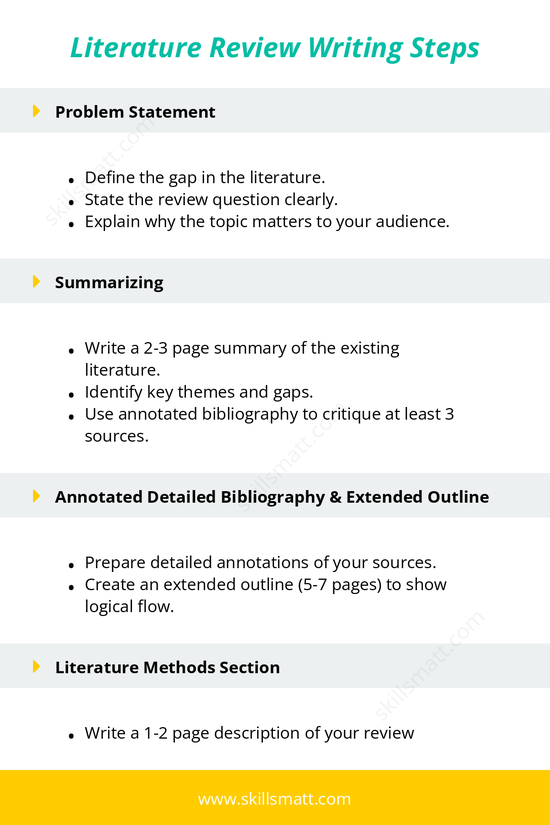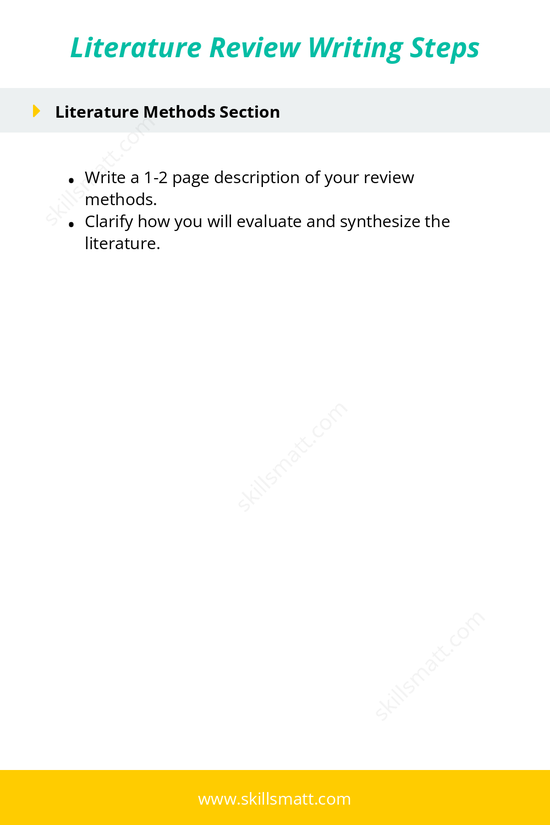Literature Review Writing Steps
Follow these steps to structure and write your literature review effectively. A well-structured review not only summarizes existing research but also critically evaluates it, highlighting gaps and areas for further research.
Problem Statement
- Define the gap in the literature: The first step is to identify the gap in existing research that your literature review aims to address. What is missing in the current body of work, and how does your review fill this gap?
- State the review question clearly: Formulate a clear, focused research question that your literature review will address. This question will guide your review and help you stay focused on the key issues.
- Explain why the topic matters to your audience: Highlight the relevance of your topic to the field and to your readers. Explain why your review is important and how it will contribute to the existing body of knowledge in your discipline.
Summarizing
- Write a 2-3 page summary of the existing literature: Synthesize the key findings of the literature you have reviewed, providing a concise summary of important studies, theories, and arguments. Make sure to highlight the most significant contributions to the topic.
- Identify key themes and gaps: As you summarize the literature, identify recurring themes, trends, and contradictions. Pinpoint any gaps in research or areas where more investigation is needed. This will form the basis of your analysis and critique.
- Use annotated bibliography to critique at least 3 sources: Select at least three key sources and write detailed annotations. Critique the strengths and weaknesses of each source, and discuss how it contributes to your understanding of the topic. This will help demonstrate the depth of your analysis.
Annotated Detailed Bibliography & Extended Outline
- Prepare detailed annotations of your sources: Annotate each source with key information, such as its findings, methodology, and relevance to your review question. This will help provide context for the sources and make it easier to integrate them into your review.
- Create an extended outline (5-7 pages) to show logical flow: Develop a comprehensive outline that organizes your review into clear sections. This outline should reflect the logical progression of ideas and arguments, ensuring that your literature review is coherent and well-structured.
Literature Methods Section
- Write a 1-2 page description of your review methods: Explain the methods you used to conduct your literature review. What criteria did you use to select your sources? What search strategies or databases did you rely on? Were there any inclusion or exclusion criteria?
- Clarify how you will evaluate and synthesize the literature: Detail how you will evaluate the sources and synthesize the findings. Will you compare methodologies, assess the quality of the evidence, or examine the consistency of conclusions across studies?
Simple Outline
- Prepare a simple outline (1-2 pages) focusing on emerging ideas: Based on your summary and annotations, prepare a more concise outline that focuses on the emerging trends, ideas, and findings. This will serve as a high-level overview of your literature review.
- Outline your discovery and advocacy arguments: Structure your outline to highlight any new discoveries you have made during your review process, as well as any advocacy points or recommendations for future research.
Seeking Feedback
- Seek feedback from experts, semi-experts, and non-experts: Reach out to a diverse group of individuals to provide feedback on your review. Experts can help ensure your analysis is thorough and accurate, while non-experts can help ensure your writing is accessible to a broader audience.
- Revise drafts based on peer and expert feedback: After gathering feedback, revise your drafts to address any suggestions or concerns. Incorporate additional evidence, refine your arguments, and ensure your review flows logically and smoothly.
Drafting
- Begin drafting your review: Use your outline and annotated bibliography as the foundation for drafting your literature review. Ensure that you present a clear, concise, and balanced analysis of the literature. Focus on presenting the most relevant information in a coherent structure.
- Follow the appropriate citation style: Ensure that you use the correct citation style (APA, MLA, Chicago, etc.) for all sources, and be consistent throughout the document.
Finalizing Your Literature Review
- Revise for clarity, coherence, and flow: Review your draft for clarity and logical flow. Ensure that each section of your review connects with the next, and that your analysis is clearly explained.
- Ensure proper formatting and citations: Check that your review adheres to the appropriate formatting guidelines, including title pages, page numbers, and proper citation formatting.
- Proofread your work: Finally, proofread your literature review carefully to catch any grammatical or typographical errors. A polished and error-free document will enhance the quality of your work.
By following these steps, you will be able to write a comprehensive, well-structured literature review that provides valuable insights into existing research while highlighting areas for further study.


